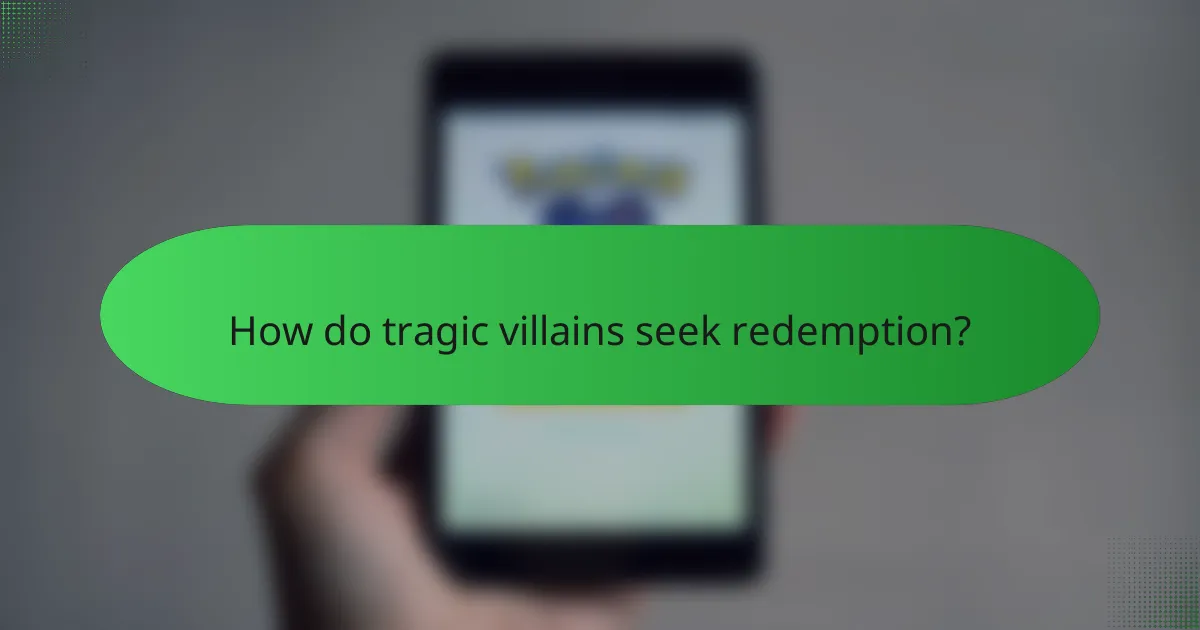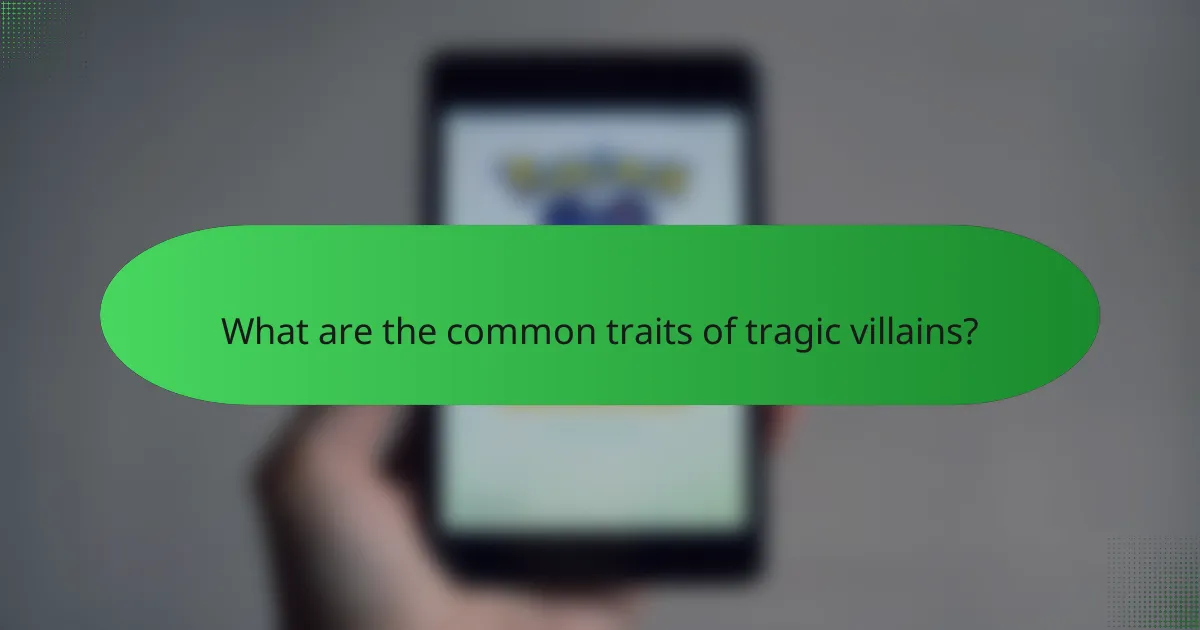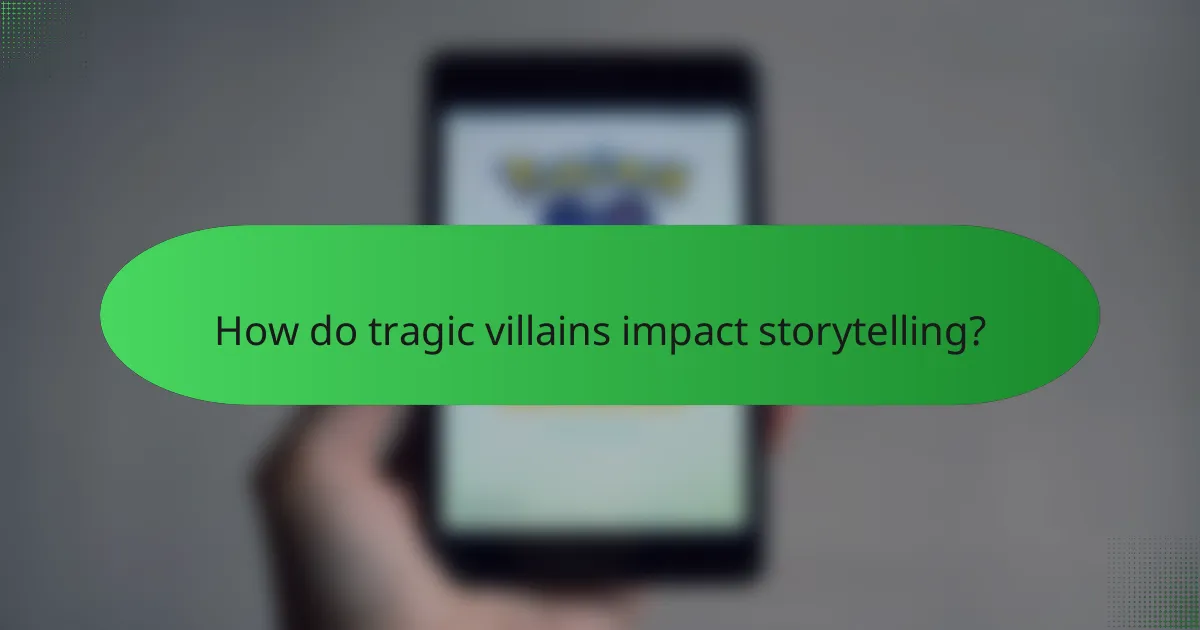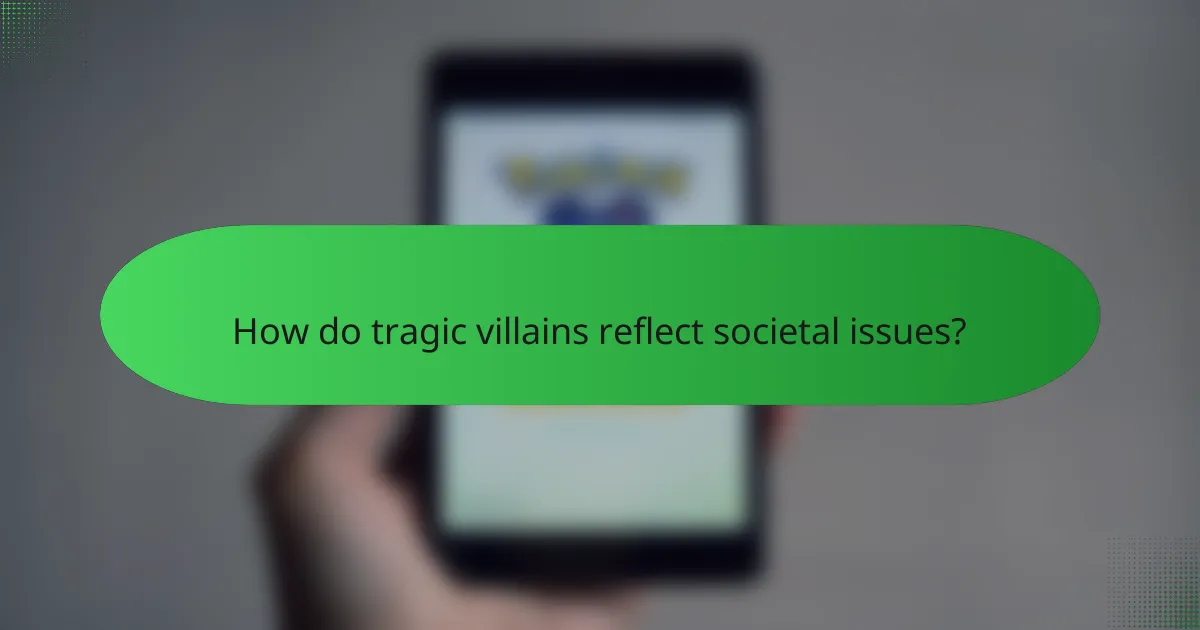Tragic villains are complex characters driven by a heartbreaking past and a desperate quest for redemption. Their misunderstood actions and painful histories evoke sympathy, inviting audiences to explore the depths of their motivations and the moral dilemmas they face. Through their journeys of self-discovery, these characters enrich storytelling by adding emotional resonance and prompting reflection on the nature of good and evil.

How do tragic villains seek redemption?
Tragic villains seek redemption by confronting their past mistakes and striving to make amends for their wrongdoings. This often involves a journey of self-discovery, where they grapple with their motivations and the consequences of their actions.
Character arcs in literature
In literature, tragic villains often undergo significant character arcs that highlight their internal struggles. These arcs typically begin with a flawed character who makes poor choices, leading to a downfall. As the story progresses, they may experience moments of clarity that prompt them to seek redemption, often through acts of bravery or selflessness.
For instance, a character might start as a ruthless leader but gradually reveal a backstory filled with trauma and loss. This transformation can evoke empathy from readers, making their quest for redemption more compelling.
Redemption through sacrifice
Many tragic villains find redemption through acts of sacrifice, where they put themselves at risk to save others or rectify their past mistakes. This selfless behavior often serves as a turning point in their character development, showcasing their growth and willingness to change.
For example, a villain might sacrifice their own safety to protect an innocent character, demonstrating that they are capable of love and bravery despite their previous actions. Such sacrifices not only redeem the character but also resonate with audiences, reinforcing the theme of redemption.
Examples from film
Film offers numerous examples of tragic villains seeking redemption, often through compelling narratives. Characters like Darth Vader from the “Star Wars” series illustrate this journey well; his ultimate sacrifice to save his son signifies his redemption after years of darkness.
Another example is the character of Severus Snape from the “Harry Potter” series, whose complex backstory reveals a lifetime of regret and unrequited love. His actions, motivated by a desire to protect Harry, ultimately lead to his redemption, showcasing the depth of his character.

What are the common traits of tragic villains?
Tragic villains often share traits that evoke sympathy, such as a painful past, misunderstood intentions, and complex moral choices. These characteristics create a compelling narrative that highlights their quest for redemption.
Heartbreaking backstories
Tragic villains typically have backstories filled with trauma, loss, or betrayal that shape their actions. For instance, a character who lost a loved one to violence may turn to crime as a means of coping or seeking revenge. This emotional depth makes their journey relatable and often elicits empathy from the audience.
Such backstories can include themes of abandonment, poverty, or societal rejection, which contribute to their villainous path. By understanding their origins, viewers can see the humanity behind their choices, making them more than just antagonists.
Misunderstood motivations
The motivations of tragic villains are often misinterpreted by others, leading to conflict and further isolation. For example, a villain might believe they are acting for the greater good, even if their methods are harmful. This disconnect between intention and perception adds layers to their character and invites the audience to question the nature of morality.
These motivations can stem from a desire for power, revenge, or a misguided sense of justice. Recognizing these complexities can help audiences appreciate the tragic dimensions of their actions, rather than viewing them as purely evil.
Complex moral dilemmas
Tragic villains frequently face moral dilemmas that challenge their values and beliefs. They may struggle between their desire for redemption and the actions they take to achieve it, often leading to a cycle of guilt and further wrongdoing. This internal conflict makes their journey compelling and relatable.
For instance, a villain might grapple with the choice of sacrificing innocent lives to save a loved one, highlighting the gray areas of morality. These dilemmas force both the character and the audience to confront difficult questions about right and wrong, ultimately enriching the narrative experience.

How do tragic villains impact storytelling?
Tragic villains significantly enhance storytelling by adding layers of complexity and emotional resonance. Their heartbreaking pasts and misunderstood actions create a compelling narrative that captivates audiences and invites deeper reflection on morality and redemption.
Driving emotional engagement
Tragic villains evoke strong emotional responses from audiences, making them feel sympathy or even sorrow for the character’s plight. This emotional engagement can be achieved through backstory revelations that highlight their suffering or the circumstances that led to their downfall.
For example, a villain who lost a loved one may resort to destructive actions out of grief, allowing viewers to connect with their pain. This connection can lead to a more invested audience, eager to see how the character’s journey unfolds.
Creating empathy in audiences
Empathy is fostered when audiences understand the motivations behind a tragic villain’s actions. By presenting their struggles and vulnerabilities, storytellers can encourage viewers to see the humanity in these characters, despite their misdeeds.
For instance, a villain who turns to crime to provide for their family may elicit compassion, challenging the audience to consider the moral complexities of their choices. This empathetic lens can shift perceptions and create a more nuanced understanding of right and wrong.
Enhancing narrative depth
Tragic villains add depth to narratives by introducing moral ambiguity and challenging traditional notions of good versus evil. Their complex motivations and backgrounds can serve as a catalyst for character development and plot progression.
Incorporating a tragic villain can elevate the stakes of a story, prompting protagonists to confront their own values and decisions. This interplay enriches the narrative, making it more engaging and thought-provoking for the audience.

What are notable examples of tragic villains in popular culture?
Tragic villains in popular culture often have heartbreaking pasts that lead to misunderstood actions and a quest for redemption. These characters evoke sympathy despite their wrongdoings, illustrating the complexity of human nature.
Darth Vader in Star Wars
Darth Vader, originally Anakin Skywalker, is a prime example of a tragic villain. His fall to the dark side stems from a combination of fear, loss, and manipulation, ultimately leading him to commit heinous acts in the name of power and control.
Despite his actions, Vader’s story is rooted in a desire to protect those he loves, making his eventual redemption arc poignant. His internal struggle highlights the conflict between good and evil within him, resonating with audiences worldwide.
Severus Snape in Harry Potter
Severus Snape is a tragic figure whose life is marked by unrequited love and deep regret. His actions, often perceived as villainous, are driven by a desire to protect Harry Potter, stemming from his past with Lily Potter.
Snape’s complex motivations and ultimate sacrifice reveal the depth of his character, showcasing how love and loss can lead to a lifetime of misunderstood choices. His journey emphasizes the themes of redemption and the gray areas of morality.
Walter White in Breaking Bad
Walter White transforms from a mild-mannered chemistry teacher to a ruthless drug lord, driven by desperation to provide for his family after a terminal cancer diagnosis. His initial intentions are rooted in love, but his choices spiral into a quest for power and control.
As Walter descends further into the criminal world, his tragic flaws become evident, illustrating how good intentions can lead to devastating consequences. His story serves as a cautionary tale about the dangers of pride and the moral complexities of his actions.

How do tragic villains reflect societal issues?
Tragic villains often embody societal issues, showcasing how personal pain and misunderstanding can lead to destructive choices. Their narratives highlight the complexities of human behavior and the impact of external factors on individual morality.
Exploring themes of loss
The theme of loss is central to the development of tragic villains, often stemming from significant personal tragedies such as the death of a loved one or the loss of a cherished dream. These experiences can distort their worldview, leading to actions that society may deem villainous.
For instance, a character who loses their family may seek revenge against those they blame, illustrating how grief can fuel destructive behavior. This portrayal encourages audiences to empathize with their pain while questioning the morality of their choices.
Commentary on morality
Tragic villains challenge conventional notions of morality by blurring the lines between right and wrong. Their actions, though harmful, often stem from a place of desperation or a misguided sense of justice, prompting audiences to reconsider their judgments.
For example, a villain who commits crimes to provide for their family may evoke sympathy, raising questions about societal responsibility and the circumstances that drive individuals to such extremes. This complexity invites discussions about ethical dilemmas and the gray areas of human behavior.
Representation of mental health struggles
Many tragic villains represent mental health struggles, highlighting the often-overlooked connection between psychological issues and harmful actions. Their backstories frequently include trauma, neglect, or untreated mental illness, which can lead to their downfall.
By portraying these struggles, narratives can foster greater understanding and compassion for those facing similar challenges in real life. This representation serves as a reminder of the importance of mental health support and the potential consequences of societal neglect.

What frameworks can analyze tragic villains?
Frameworks that analyze tragic villains focus on their complex motivations, emotional struggles, and the societal factors that shape their actions. These frameworks help to understand how a villain’s heartbreaking past and misunderstood actions contribute to their quest for redemption.
Character Development Models
Character development models, such as the Hero’s Journey and the Five Stages of Grief, can effectively analyze tragic villains. These models outline the emotional arcs that characters undergo, highlighting the pivotal moments that lead to their downfall. For instance, a villain may start as a sympathetic figure who experiences loss, leading to their eventual transformation into an antagonist.
By mapping a villain’s journey through these frameworks, writers can create more nuanced characters that resonate with audiences. Understanding the stages of their emotional turmoil can provide insight into their motivations and actions.
Psychological Theories
Psychological theories, including Maslow’s Hierarchy of Needs and Jungian archetypes, offer valuable perspectives on tragic villains. These theories can explain how unmet needs or internal conflicts drive a character’s descent into villainy. For example, a character who feels abandoned may resort to destructive behaviors to regain a sense of control.
Utilizing these psychological frameworks allows for a deeper exploration of a villain’s psyche, making their actions more relatable and grounded in human experience. This approach encourages audiences to empathize with their struggles, even when they commit heinous acts.
Societal Context Analysis
Societal context analysis examines how external factors, such as culture, socioeconomic status, and historical events, influence a tragic villain’s actions. This framework highlights the impact of societal expectations and pressures on individual behavior. A villain may emerge from a marginalized community, driven to crime by systemic injustices.
By considering the societal context, writers can craft villains whose actions reflect broader themes of injustice and inequality. This not only enriches the narrative but also invites discussions about the moral complexities surrounding villainy.
